PUBH620 Biostatistics Report: Statistical Methods in Public Health
VerifiedAdded on 2023/03/31
|6
|1347
|492
Report
AI Summary
This report provides a detailed overview of biostatistics, emphasizing the application of statistical tools in the context of biology and health sciences. It explores various statistical methods including descriptive statistics, measures of central tendency (mean, median, mode), correlation and regression analysis, and analysis of variance (ANOVA). The report discusses how these tools are used to analyze data, interpret health-related information, monitor patient mobility rates, and track emerging diseases. It also highlights the importance of accurate data collection and interpretation to avoid misrepresentation of results. The document further elaborates on partial correlation, multiple regression techniques, and their significance in determining relationships between variables. The report concludes by underscoring the broad applicability of biostatistics and its critical role in public health research and practice. Desklib provides access to similar solved assignments and past papers for students.
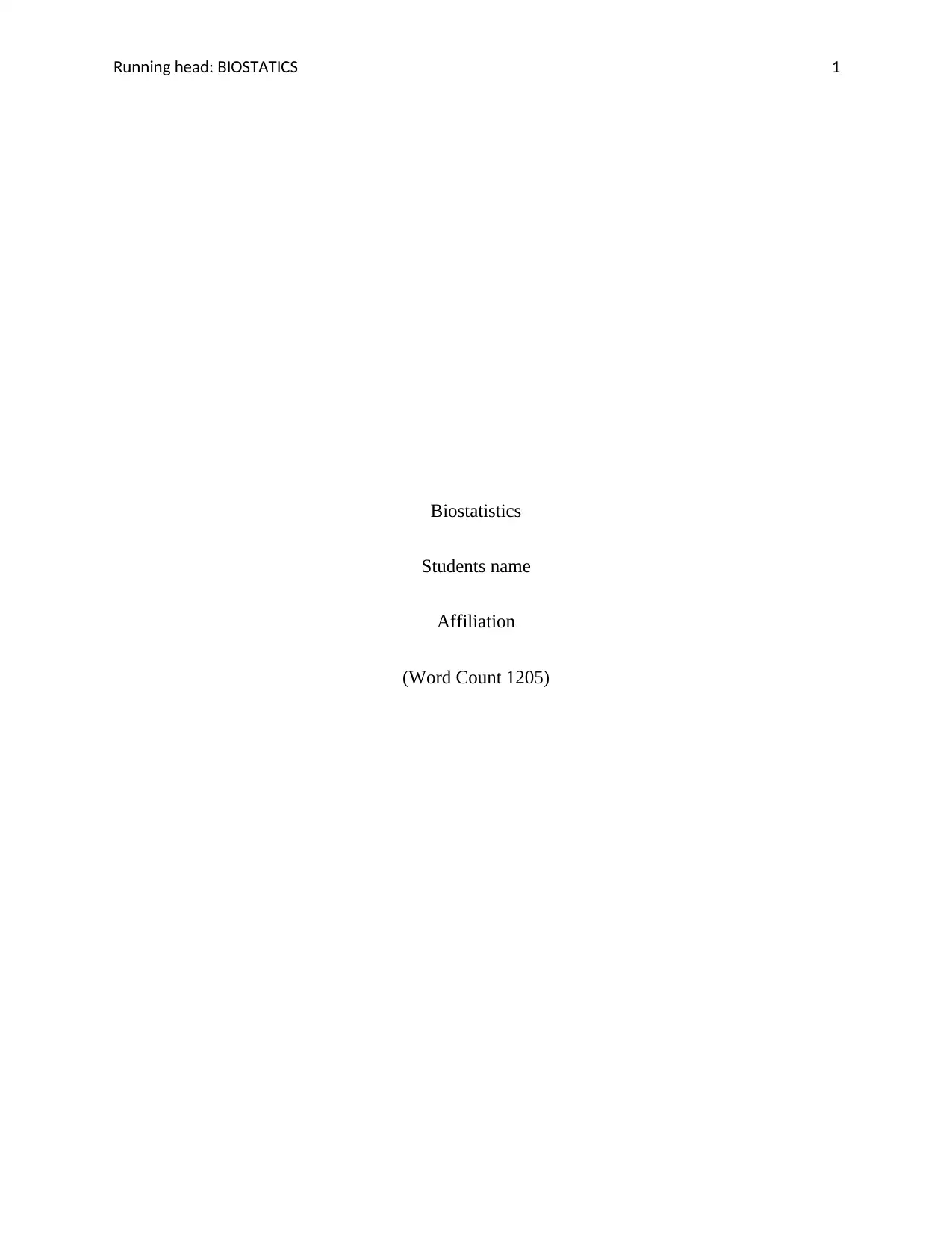
Running head: BIOSTATICS 1
Biostatistics
Students name
Affiliation
(Word Count 1205)
Biostatistics
Students name
Affiliation
(Word Count 1205)
Paraphrase This Document
Need a fresh take? Get an instant paraphrase of this document with our AI Paraphraser
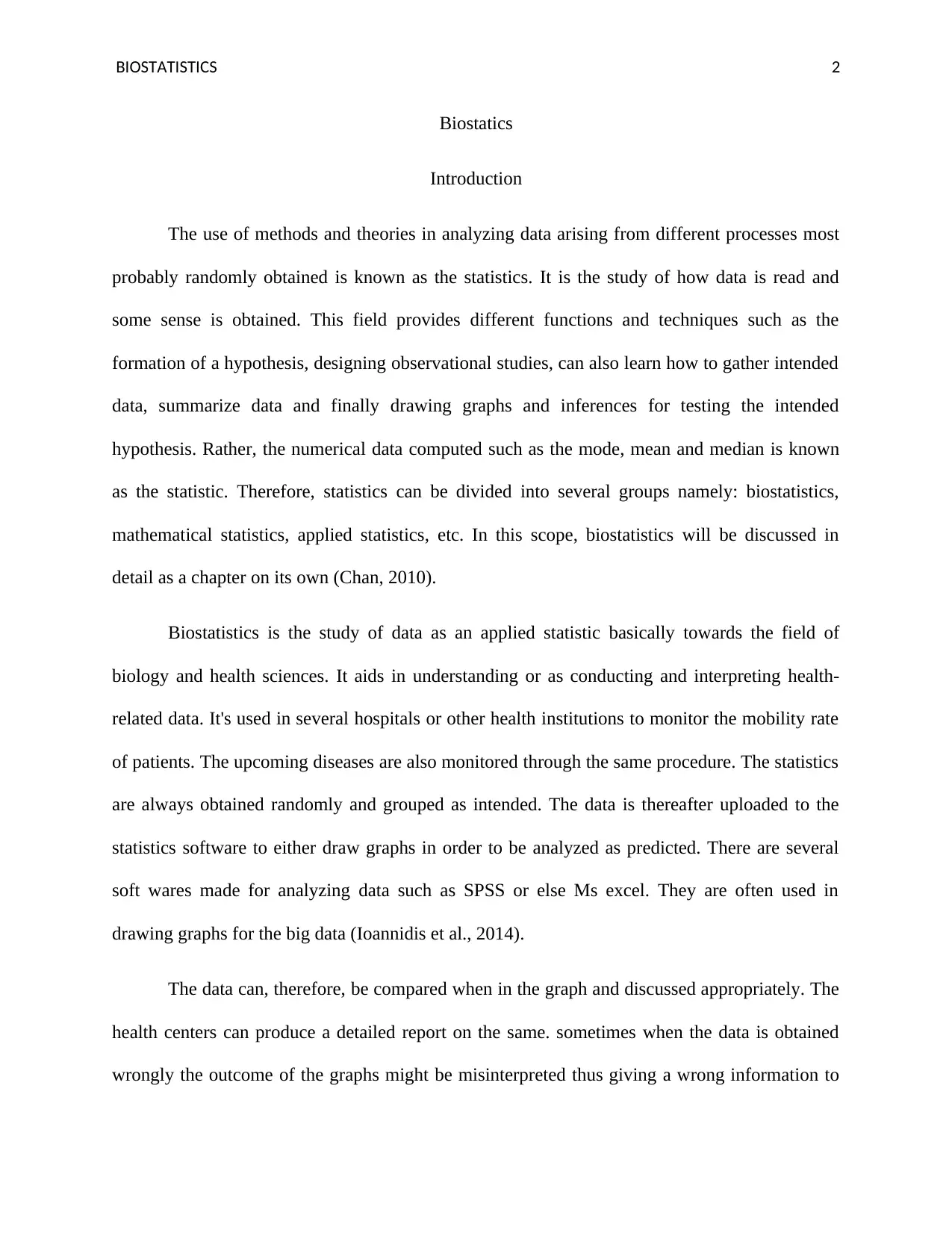
BIOSTATISTICS 2
Biostatics
Introduction
The use of methods and theories in analyzing data arising from different processes most
probably randomly obtained is known as the statistics. It is the study of how data is read and
some sense is obtained. This field provides different functions and techniques such as the
formation of a hypothesis, designing observational studies, can also learn how to gather intended
data, summarize data and finally drawing graphs and inferences for testing the intended
hypothesis. Rather, the numerical data computed such as the mode, mean and median is known
as the statistic. Therefore, statistics can be divided into several groups namely: biostatistics,
mathematical statistics, applied statistics, etc. In this scope, biostatistics will be discussed in
detail as a chapter on its own (Chan, 2010).
Biostatistics is the study of data as an applied statistic basically towards the field of
biology and health sciences. It aids in understanding or as conducting and interpreting health-
related data. It's used in several hospitals or other health institutions to monitor the mobility rate
of patients. The upcoming diseases are also monitored through the same procedure. The statistics
are always obtained randomly and grouped as intended. The data is thereafter uploaded to the
statistics software to either draw graphs in order to be analyzed as predicted. There are several
soft wares made for analyzing data such as SPSS or else Ms excel. They are often used in
drawing graphs for the big data (Ioannidis et al., 2014).
The data can, therefore, be compared when in the graph and discussed appropriately. The
health centers can produce a detailed report on the same. sometimes when the data is obtained
wrongly the outcome of the graphs might be misinterpreted thus giving a wrong information to
Biostatics
Introduction
The use of methods and theories in analyzing data arising from different processes most
probably randomly obtained is known as the statistics. It is the study of how data is read and
some sense is obtained. This field provides different functions and techniques such as the
formation of a hypothesis, designing observational studies, can also learn how to gather intended
data, summarize data and finally drawing graphs and inferences for testing the intended
hypothesis. Rather, the numerical data computed such as the mode, mean and median is known
as the statistic. Therefore, statistics can be divided into several groups namely: biostatistics,
mathematical statistics, applied statistics, etc. In this scope, biostatistics will be discussed in
detail as a chapter on its own (Chan, 2010).
Biostatistics is the study of data as an applied statistic basically towards the field of
biology and health sciences. It aids in understanding or as conducting and interpreting health-
related data. It's used in several hospitals or other health institutions to monitor the mobility rate
of patients. The upcoming diseases are also monitored through the same procedure. The statistics
are always obtained randomly and grouped as intended. The data is thereafter uploaded to the
statistics software to either draw graphs in order to be analyzed as predicted. There are several
soft wares made for analyzing data such as SPSS or else Ms excel. They are often used in
drawing graphs for the big data (Ioannidis et al., 2014).
The data can, therefore, be compared when in the graph and discussed appropriately. The
health centers can produce a detailed report on the same. sometimes when the data is obtained
wrongly the outcome of the graphs might be misinterpreted thus giving a wrong information to
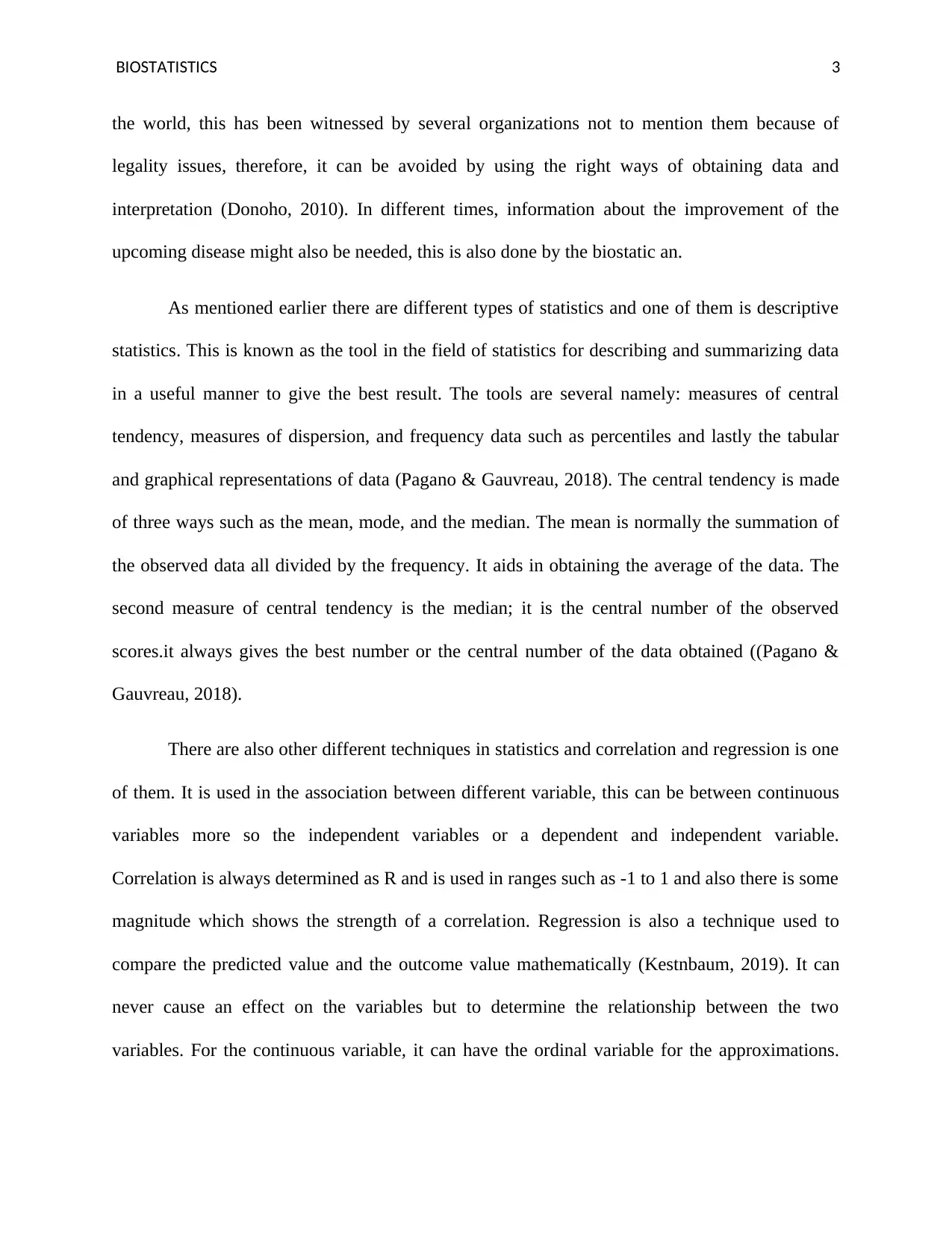
BIOSTATISTICS 3
the world, this has been witnessed by several organizations not to mention them because of
legality issues, therefore, it can be avoided by using the right ways of obtaining data and
interpretation (Donoho, 2010). In different times, information about the improvement of the
upcoming disease might also be needed, this is also done by the biostatic an.
As mentioned earlier there are different types of statistics and one of them is descriptive
statistics. This is known as the tool in the field of statistics for describing and summarizing data
in a useful manner to give the best result. The tools are several namely: measures of central
tendency, measures of dispersion, and frequency data such as percentiles and lastly the tabular
and graphical representations of data (Pagano & Gauvreau, 2018). The central tendency is made
of three ways such as the mean, mode, and the median. The mean is normally the summation of
the observed data all divided by the frequency. It aids in obtaining the average of the data. The
second measure of central tendency is the median; it is the central number of the observed
scores.it always gives the best number or the central number of the data obtained ((Pagano &
Gauvreau, 2018).
There are also other different techniques in statistics and correlation and regression is one
of them. It is used in the association between different variable, this can be between continuous
variables more so the independent variables or a dependent and independent variable.
Correlation is always determined as R and is used in ranges such as -1 to 1 and also there is some
magnitude which shows the strength of a correlation. Regression is also a technique used to
compare the predicted value and the outcome value mathematically (Kestnbaum, 2019). It can
never cause an effect on the variables but to determine the relationship between the two
variables. For the continuous variable, it can have the ordinal variable for the approximations.
the world, this has been witnessed by several organizations not to mention them because of
legality issues, therefore, it can be avoided by using the right ways of obtaining data and
interpretation (Donoho, 2010). In different times, information about the improvement of the
upcoming disease might also be needed, this is also done by the biostatic an.
As mentioned earlier there are different types of statistics and one of them is descriptive
statistics. This is known as the tool in the field of statistics for describing and summarizing data
in a useful manner to give the best result. The tools are several namely: measures of central
tendency, measures of dispersion, and frequency data such as percentiles and lastly the tabular
and graphical representations of data (Pagano & Gauvreau, 2018). The central tendency is made
of three ways such as the mean, mode, and the median. The mean is normally the summation of
the observed data all divided by the frequency. It aids in obtaining the average of the data. The
second measure of central tendency is the median; it is the central number of the observed
scores.it always gives the best number or the central number of the data obtained ((Pagano &
Gauvreau, 2018).
There are also other different techniques in statistics and correlation and regression is one
of them. It is used in the association between different variable, this can be between continuous
variables more so the independent variables or a dependent and independent variable.
Correlation is always determined as R and is used in ranges such as -1 to 1 and also there is some
magnitude which shows the strength of a correlation. Regression is also a technique used to
compare the predicted value and the outcome value mathematically (Kestnbaum, 2019). It can
never cause an effect on the variables but to determine the relationship between the two
variables. For the continuous variable, it can have the ordinal variable for the approximations.
⊘ This is a preview!⊘
Do you want full access?
Subscribe today to unlock all pages.

Trusted by 1+ million students worldwide
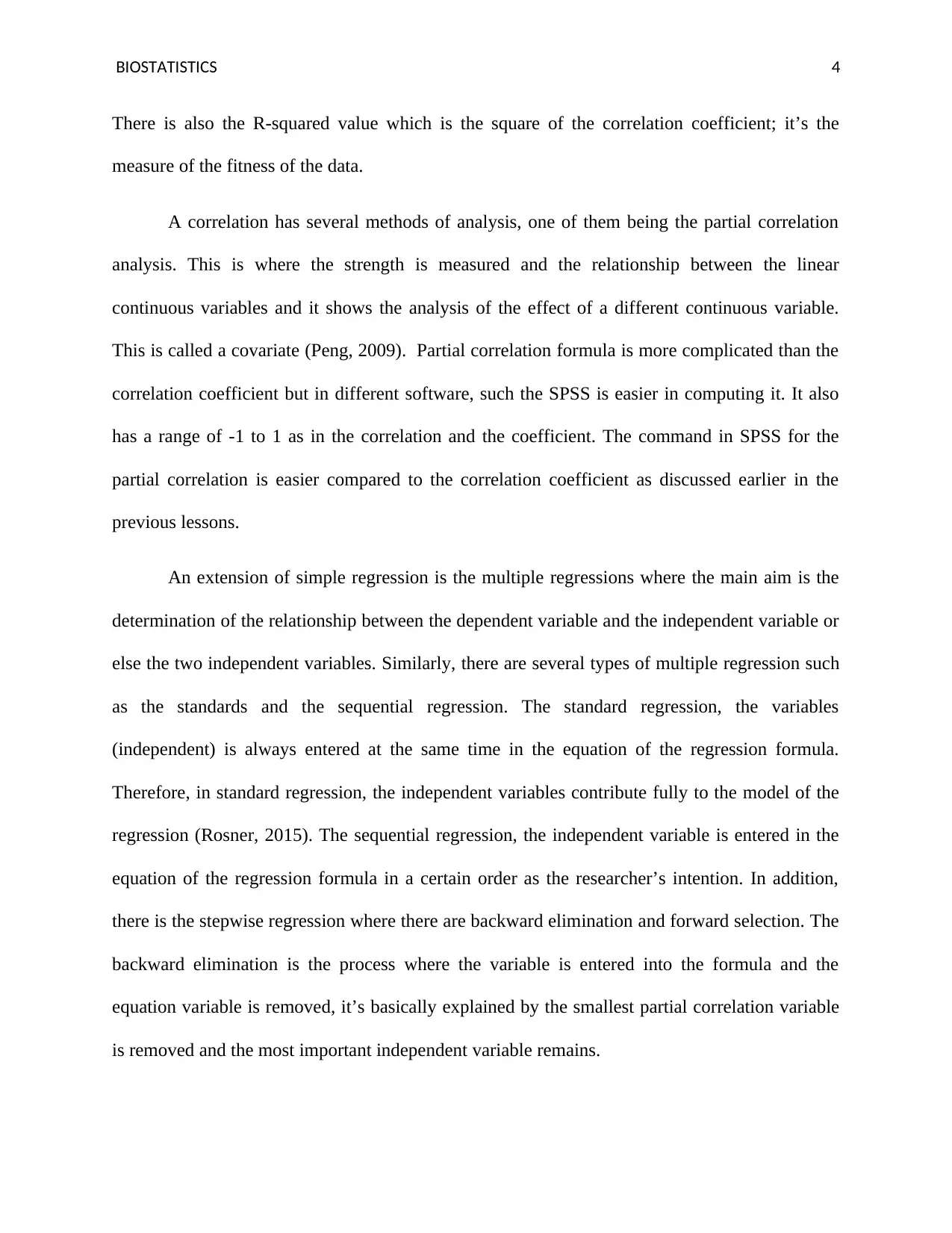
BIOSTATISTICS 4
There is also the R-squared value which is the square of the correlation coefficient; it’s the
measure of the fitness of the data.
A correlation has several methods of analysis, one of them being the partial correlation
analysis. This is where the strength is measured and the relationship between the linear
continuous variables and it shows the analysis of the effect of a different continuous variable.
This is called a covariate (Peng, 2009). Partial correlation formula is more complicated than the
correlation coefficient but in different software, such the SPSS is easier in computing it. It also
has a range of -1 to 1 as in the correlation and the coefficient. The command in SPSS for the
partial correlation is easier compared to the correlation coefficient as discussed earlier in the
previous lessons.
An extension of simple regression is the multiple regressions where the main aim is the
determination of the relationship between the dependent variable and the independent variable or
else the two independent variables. Similarly, there are several types of multiple regression such
as the standards and the sequential regression. The standard regression, the variables
(independent) is always entered at the same time in the equation of the regression formula.
Therefore, in standard regression, the independent variables contribute fully to the model of the
regression (Rosner, 2015). The sequential regression, the independent variable is entered in the
equation of the regression formula in a certain order as the researcher’s intention. In addition,
there is the stepwise regression where there are backward elimination and forward selection. The
backward elimination is the process where the variable is entered into the formula and the
equation variable is removed, it’s basically explained by the smallest partial correlation variable
is removed and the most important independent variable remains.
There is also the R-squared value which is the square of the correlation coefficient; it’s the
measure of the fitness of the data.
A correlation has several methods of analysis, one of them being the partial correlation
analysis. This is where the strength is measured and the relationship between the linear
continuous variables and it shows the analysis of the effect of a different continuous variable.
This is called a covariate (Peng, 2009). Partial correlation formula is more complicated than the
correlation coefficient but in different software, such the SPSS is easier in computing it. It also
has a range of -1 to 1 as in the correlation and the coefficient. The command in SPSS for the
partial correlation is easier compared to the correlation coefficient as discussed earlier in the
previous lessons.
An extension of simple regression is the multiple regressions where the main aim is the
determination of the relationship between the dependent variable and the independent variable or
else the two independent variables. Similarly, there are several types of multiple regression such
as the standards and the sequential regression. The standard regression, the variables
(independent) is always entered at the same time in the equation of the regression formula.
Therefore, in standard regression, the independent variables contribute fully to the model of the
regression (Rosner, 2015). The sequential regression, the independent variable is entered in the
equation of the regression formula in a certain order as the researcher’s intention. In addition,
there is the stepwise regression where there are backward elimination and forward selection. The
backward elimination is the process where the variable is entered into the formula and the
equation variable is removed, it’s basically explained by the smallest partial correlation variable
is removed and the most important independent variable remains.
Paraphrase This Document
Need a fresh take? Get an instant paraphrase of this document with our AI Paraphraser
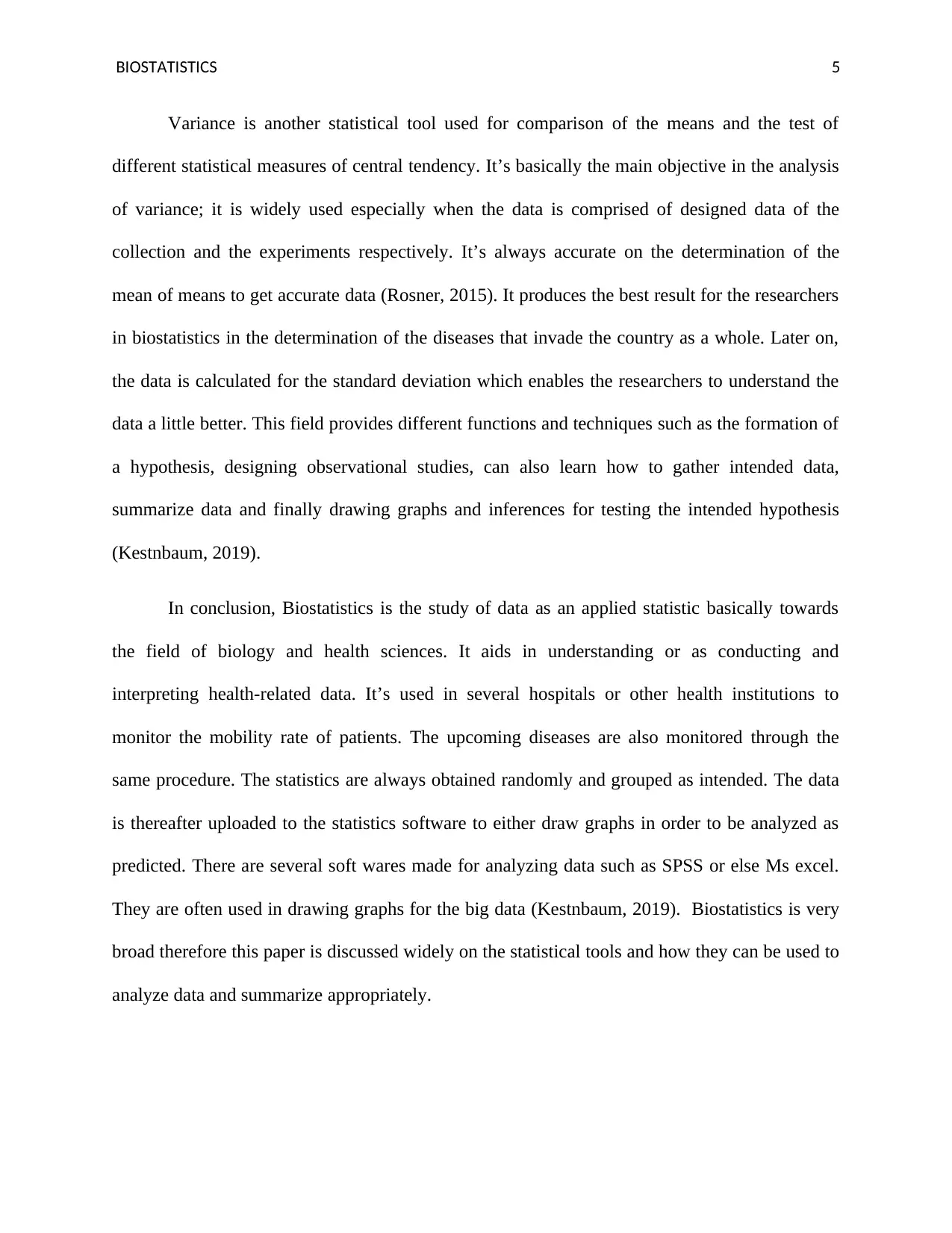
BIOSTATISTICS 5
Variance is another statistical tool used for comparison of the means and the test of
different statistical measures of central tendency. It’s basically the main objective in the analysis
of variance; it is widely used especially when the data is comprised of designed data of the
collection and the experiments respectively. It’s always accurate on the determination of the
mean of means to get accurate data (Rosner, 2015). It produces the best result for the researchers
in biostatistics in the determination of the diseases that invade the country as a whole. Later on,
the data is calculated for the standard deviation which enables the researchers to understand the
data a little better. This field provides different functions and techniques such as the formation of
a hypothesis, designing observational studies, can also learn how to gather intended data,
summarize data and finally drawing graphs and inferences for testing the intended hypothesis
(Kestnbaum, 2019).
In conclusion, Biostatistics is the study of data as an applied statistic basically towards
the field of biology and health sciences. It aids in understanding or as conducting and
interpreting health-related data. It’s used in several hospitals or other health institutions to
monitor the mobility rate of patients. The upcoming diseases are also monitored through the
same procedure. The statistics are always obtained randomly and grouped as intended. The data
is thereafter uploaded to the statistics software to either draw graphs in order to be analyzed as
predicted. There are several soft wares made for analyzing data such as SPSS or else Ms excel.
They are often used in drawing graphs for the big data (Kestnbaum, 2019). Biostatistics is very
broad therefore this paper is discussed widely on the statistical tools and how they can be used to
analyze data and summarize appropriately.
Variance is another statistical tool used for comparison of the means and the test of
different statistical measures of central tendency. It’s basically the main objective in the analysis
of variance; it is widely used especially when the data is comprised of designed data of the
collection and the experiments respectively. It’s always accurate on the determination of the
mean of means to get accurate data (Rosner, 2015). It produces the best result for the researchers
in biostatistics in the determination of the diseases that invade the country as a whole. Later on,
the data is calculated for the standard deviation which enables the researchers to understand the
data a little better. This field provides different functions and techniques such as the formation of
a hypothesis, designing observational studies, can also learn how to gather intended data,
summarize data and finally drawing graphs and inferences for testing the intended hypothesis
(Kestnbaum, 2019).
In conclusion, Biostatistics is the study of data as an applied statistic basically towards
the field of biology and health sciences. It aids in understanding or as conducting and
interpreting health-related data. It’s used in several hospitals or other health institutions to
monitor the mobility rate of patients. The upcoming diseases are also monitored through the
same procedure. The statistics are always obtained randomly and grouped as intended. The data
is thereafter uploaded to the statistics software to either draw graphs in order to be analyzed as
predicted. There are several soft wares made for analyzing data such as SPSS or else Ms excel.
They are often used in drawing graphs for the big data (Kestnbaum, 2019). Biostatistics is very
broad therefore this paper is discussed widely on the statistical tools and how they can be used to
analyze data and summarize appropriately.
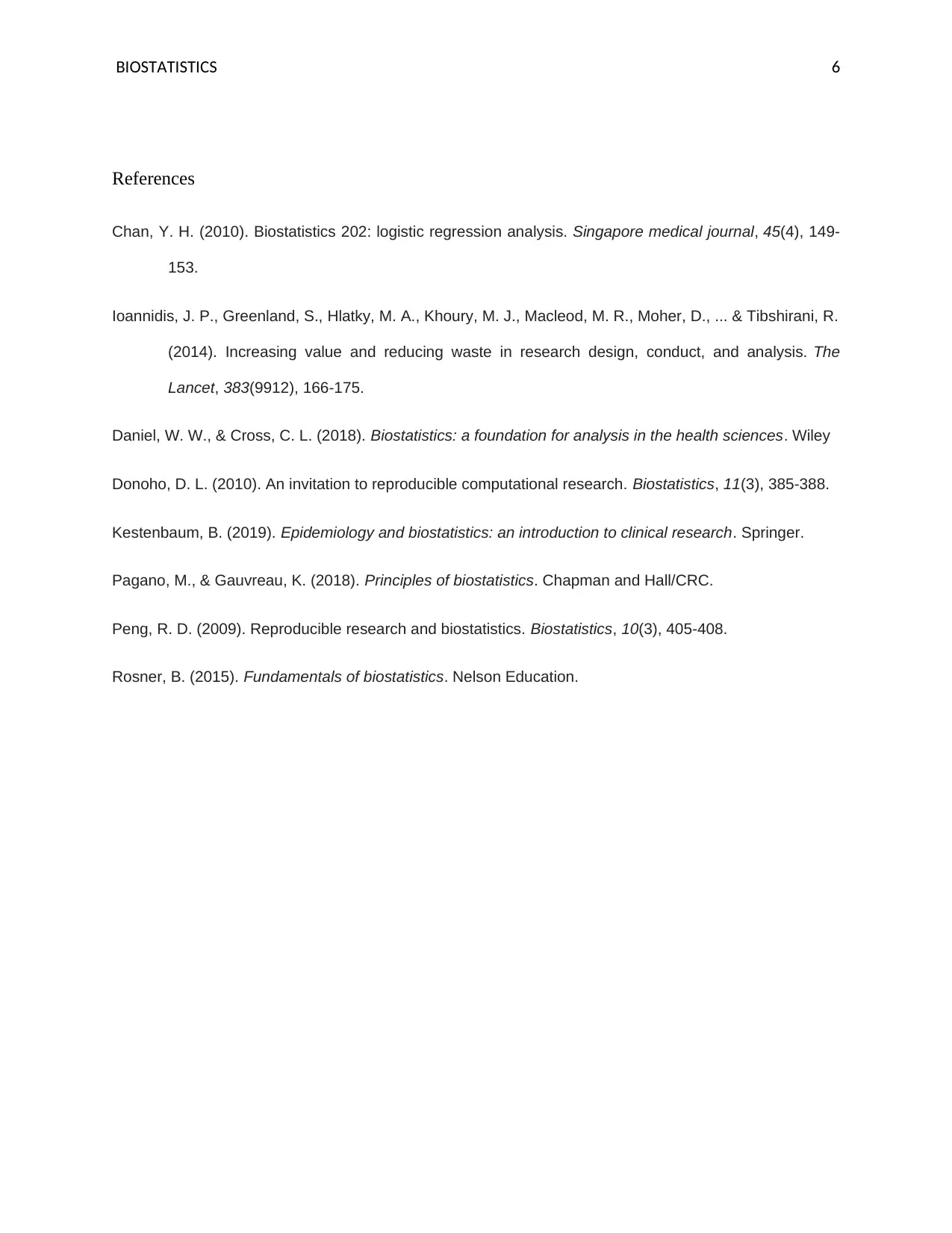
BIOSTATISTICS 6
References
Chan, Y. H. (2010). Biostatistics 202: logistic regression analysis. Singapore medical journal, 45(4), 149-
153.
Ioannidis, J. P., Greenland, S., Hlatky, M. A., Khoury, M. J., Macleod, M. R., Moher, D., ... & Tibshirani, R.
(2014). Increasing value and reducing waste in research design, conduct, and analysis. The
Lancet, 383(9912), 166-175.
Daniel, W. W., & Cross, C. L. (2018). Biostatistics: a foundation for analysis in the health sciences. Wiley
Donoho, D. L. (2010). An invitation to reproducible computational research. Biostatistics, 11(3), 385-388.
Kestenbaum, B. (2019). Epidemiology and biostatistics: an introduction to clinical research. Springer.
Pagano, M., & Gauvreau, K. (2018). Principles of biostatistics. Chapman and Hall/CRC.
Peng, R. D. (2009). Reproducible research and biostatistics. Biostatistics, 10(3), 405-408.
Rosner, B. (2015). Fundamentals of biostatistics. Nelson Education.
References
Chan, Y. H. (2010). Biostatistics 202: logistic regression analysis. Singapore medical journal, 45(4), 149-
153.
Ioannidis, J. P., Greenland, S., Hlatky, M. A., Khoury, M. J., Macleod, M. R., Moher, D., ... & Tibshirani, R.
(2014). Increasing value and reducing waste in research design, conduct, and analysis. The
Lancet, 383(9912), 166-175.
Daniel, W. W., & Cross, C. L. (2018). Biostatistics: a foundation for analysis in the health sciences. Wiley
Donoho, D. L. (2010). An invitation to reproducible computational research. Biostatistics, 11(3), 385-388.
Kestenbaum, B. (2019). Epidemiology and biostatistics: an introduction to clinical research. Springer.
Pagano, M., & Gauvreau, K. (2018). Principles of biostatistics. Chapman and Hall/CRC.
Peng, R. D. (2009). Reproducible research and biostatistics. Biostatistics, 10(3), 405-408.
Rosner, B. (2015). Fundamentals of biostatistics. Nelson Education.
⊘ This is a preview!⊘
Do you want full access?
Subscribe today to unlock all pages.

Trusted by 1+ million students worldwide
1 out of 6
Related Documents
Your All-in-One AI-Powered Toolkit for Academic Success.
+13062052269
info@desklib.com
Available 24*7 on WhatsApp / Email
![[object Object]](/_next/static/media/star-bottom.7253800d.svg)
Unlock your academic potential
Copyright © 2020–2025 A2Z Services. All Rights Reserved. Developed and managed by ZUCOL.





